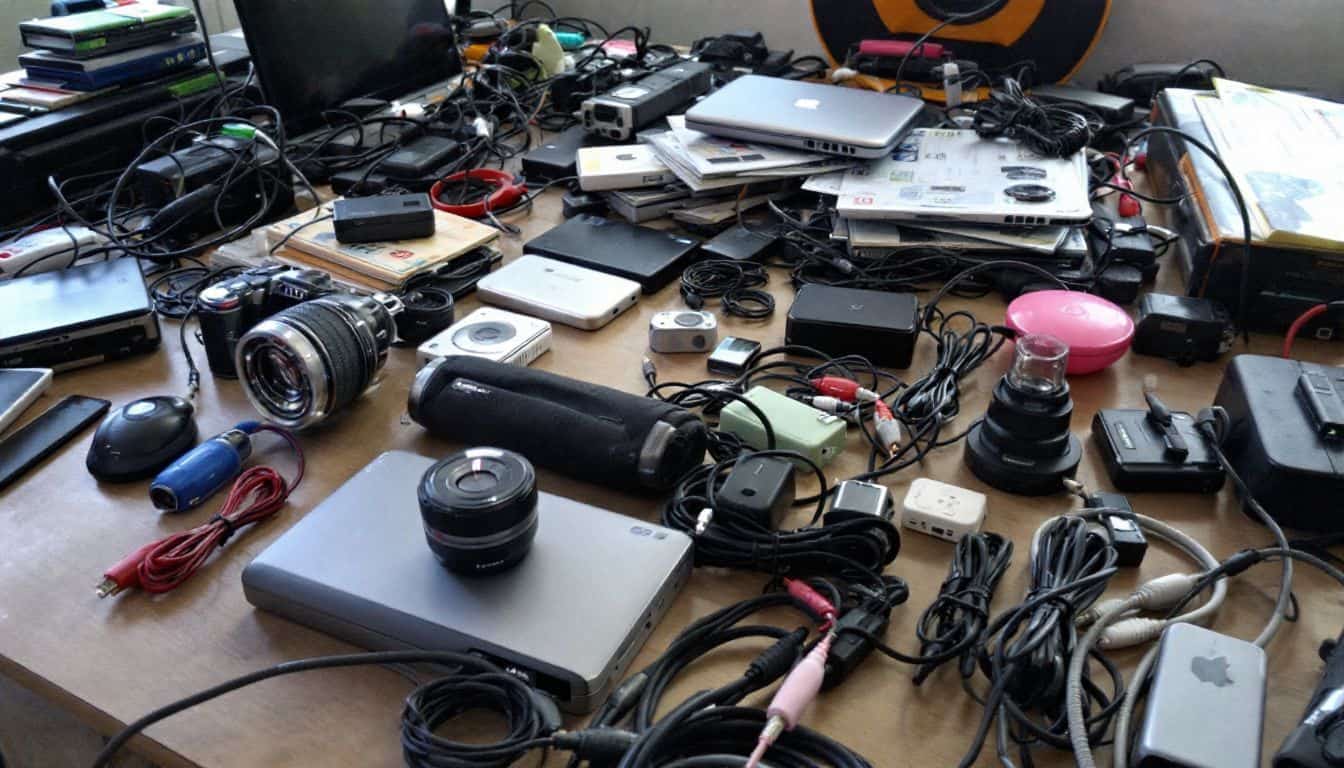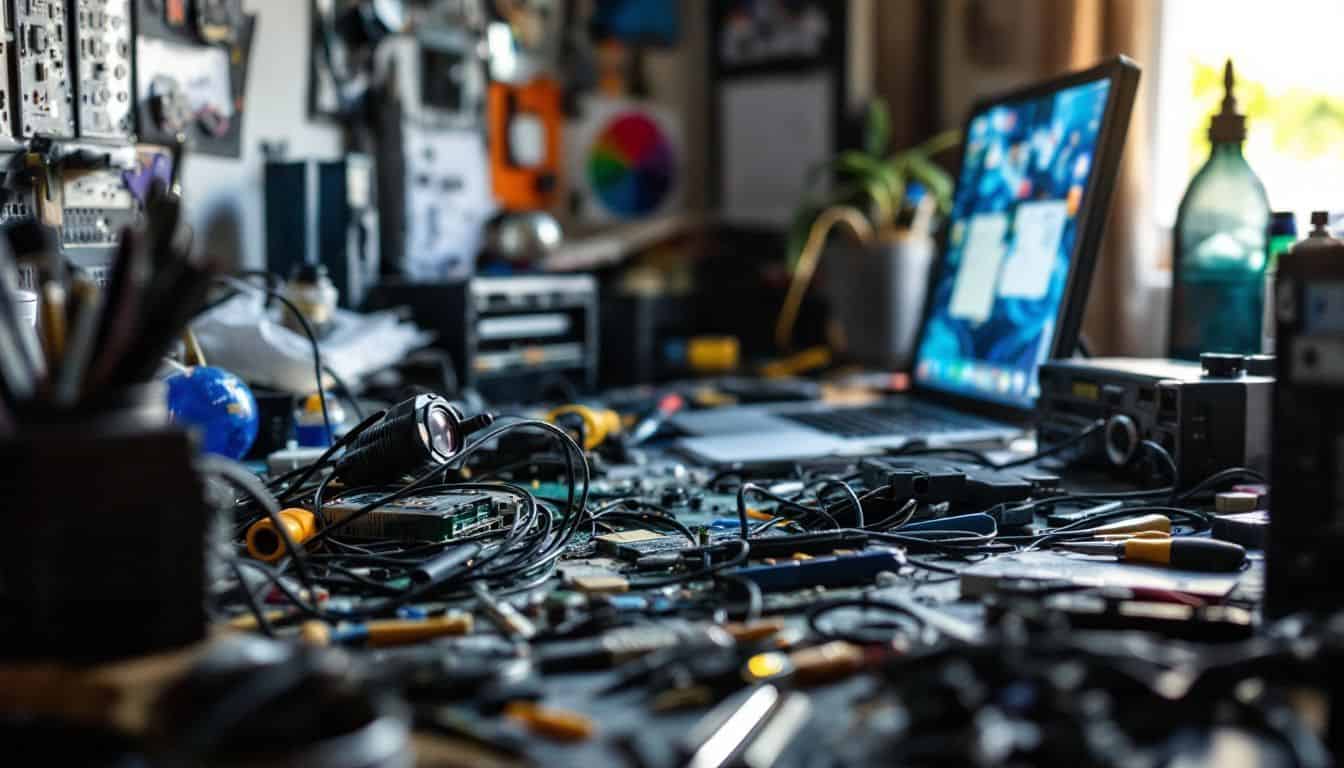Are you tired of spending too much on computers? It’s a common headache for many folks. Did you know that the average person spends over $600 on a new laptop? Don’t worry – we’ve got your back.
This guide will show you how to save money buying a computer with 9 genius hacks. Ready to stretch your dollar? Let’s go!
Key Takeaways
Know your needs and budget before buying. Use the 50/30/20 rule to set a realistic spending limit for your computer purchase.
Time your purchase during sales events like Black Friday or when new models are released to get older versions at reduced prices.
Explore refurbished or second-hand computers to save 10-25% compared to new prices. Many come with warranties for peace of mind.
Take advantage of student discounts, membership club deals, and online coupons. Sites like PCMag.com offer tech discount codes.
Use price comparison tools and trade-in old devices for discounts. Opt for basic models you can upgrade later instead of pricey high-end purchases upfront.
Table of Contents
Identifying Your Needs and Budget

Hey guys, let’s talk about buying a computer without breaking the bank. First things first – you gotta know what you need and how much you can spend. It’s like shopping for a car…
but way less stressful and way more fun!
Determine academic or professional requirements

Picking the right computer isn’t a one-size-fits-all deal. Your major or job plays a big role in what you need. Graphic design and computer science folks need beefier machines than business students.
It’s like choosing between a sports car and a minivan – both are great, but for different reasons.
Choose a job you love, and you will never have to work a day in your life.
Think about what you’ll use your computer for most. Will you be crunching numbers, editing videos, or just surfing the web? Knowing this helps you avoid overpaying for stuff you don’t need.
It’s smart to chat with your teachers or boss about what specs they recommend. This way, you’ll get a machine that can handle your workload without breaking the bank.
Establish a realistic budget

Setting a realistic budget is key when buying a computer. First, figure out how much you can spend without breaking the bank. The 50/30/20 rule can help here. Put 50% of your take-home pay toward needs, 30% for wants, and 20% for savings and paying off debt.
Your new computer likely falls under “wants,” so aim to keep it within that 30% slice. Don’t forget to factor in extras like software or accessories.
Having a solid budget keeps you from overspending. It’s tempting to go for the fanciest machine, but resist that urge! Stick to what you actually need and can afford. Maybe you don’t need the latest gaming rig – a basic Acer discount vouchers at Latest Deals could do the trick.
Plus, saving some cash now means you’ll have a cushion for unexpected costs later. Try to set aside at least $500 as a starter emergency fund. That way, you won’t end up in debt if something goes wrong with your new PC.
Optimal Timing for Purchasing a Computer

Timing is key when buying a computer. Black Friday and Cyber Monday can save you big bucks on laptops and desktops.
Capitalize on seasonal sales like Black Friday

Black Friday’s a goldmine for computer deals. Stores cut prices on laptops, desktops, and parts. It’s prime time to grab that new rig you’ve been eyeing. But don’t jump on the first deal you see – do your homework first.
Check prices weeks before to spot real bargains. Some shops raise prices right before the sale to make discounts look bigger.
Cyber Monday’s another hot day for tech savings. It’s great if you missed out on Black Friday or prefer online shopping. Keep an eye out for bundle deals too. You might score a sweet laptop with free accessories.
The early bird catches the worm, but the patient shopper catches the best deal.
Just keep in mind – popular items sell out fast. Have a plan and be ready to act when the clock strikes midnight.
Monitor new model releases

Keep an eye on new computer releases. They often signal price drops for older models. Tech giants like Apple and Dell usually launch fresh gear in spring or fall. This timing’s key for savvy shoppers.
You might snag last year’s laptop at a sweet discount when the latest version hits shelves.
Don’t rush to buy the newest tech right away. Prices tend to dip a few months after release. Patience pays off here. Plus, you’ll dodge any early bugs or issues that sometimes plague new models.
It’s a win-win – you save cash and get a more stable product. Just stay alert and ready to pounce when those deals pop up.
Assessing Various Purchase Options

Hey guys, let’s talk about smart ways to buy a computer. You don’t always have to shell out big bucks for a brand-new machine. There are some cool options out there that can save you a ton of cash – like grabbing a refurbished laptop or snagging last year’s model at a sweet discount.
Explore refurbished or second-hand computers
Looking to save some serious cash on your next computer? Check out refurbished or second-hand options. These pre-owned devices can cut your costs by 10% to 25% compared to brand-new prices.
That’s a sweet deal! Big names like Apple, Dell, and Best Buy sell these restored gems. They often come with warranties too, so you’re not taking a huge risk.
One man’s trash is another man’s treasure… especially with refurbished computers!
Don’t sweat getting a dud. These machines go through thorough testing before hitting the shelves. You might snag a MacBook Air or a speedy Windows PC for way less than retail. Just make sure to buy from trusted sellers.
It’s a smart way to upgrade your tech without emptying your wallet.
Purchase older model versions at reduced prices
Older computer models can be a real steal. Retailers often slash prices on these machines to make room for new stock. You’ll find great deals on last year’s laptops or desktops that still pack a punch.
These older versions usually have all the power you need for everyday tasks, basic gaming on your school computer, and even some heavy-duty work.
Don’t let the “older model” label fool you. Many of these computers run just as well as the latest versions. The main difference? You’ll keep more cash in your wallet. Plus, you’ll dodge the high costs that come with brand-new tech.
Next up, let’s talk about how to make the most of discounts and promos when buying your computer.
Leveraging Discounts and Promotions

Wanna save big bucks on your next computer? Let’s talk discounts and promos! You’d be amazed at how much cash you can keep in your pocket with a few savvy moves.
Secure student discounts and special deals
Student discounts are a great way to save money on computers. Colleges often partner with major tech brands to offer excellent deals. I once got a laptop for 20% off just by using my .edu email.
It’s simple – just show your student ID or sign up with your school email. Adobe’s 66% discount on Creative Cloud is an amazing deal for aspiring artists and designers. These offers aren’t limited to college students.
Teachers can often benefit from them too.
Dell has a clever approach. Sign up for an account, and you might get an extra 10% off. It’s like finding unexpected cash in your old jeans… but even better. Stay alert for these special offers.
They often appear during back-to-school season and holidays. Here’s a tip: join student clubs or tech forums. They frequently share exclusive promo codes that aren’t publicly available.
A penny saved is a penny earned… especially when buying computers.
Join membership clubs for exclusive discounts
Guys, listen up! Joining clubs like Costco isn’t just for bulk toilet paper. It’s a goldmine for computer deals. These clubs offer sweet discounts and killer warranties on tech. I snagged a laptop for 35% off last year – no joke.
Some deals even hit 50% off or buy-one-get-one. It’s like having a secret pass to savings city.
But here’s the real kicker… These clubs aren’t just about saving you cash. They’re smart business. They keep raking in money while attracting big spenders like us. It’s a win-win.
You get awesome deals, they get loyal customers. So next time you’re eyeing that shiny new Chromebook or MacBook Pro, think about joining a club first. Your wallet will thank you.
Search for coupons and promotional codes
Guys, listen up! Hunting for coupons and promo codes is a smart move. It’s like finding free money. I once scored a sweet $100 off a laptop just by googling for five minutes. No joke! Most folks (92% to be exact) always look for deals before buying stuff online.
It’s a no-brainer.
Here’s a pro tip: Check out PCMag.com for some killer coupon codes. They’ve got the hookup on tech deals. And don’t stop there. Dig around on social media, sign up for email lists, or use browser extensions that find codes for you.
It’s easy cash in your pocket, fellas. Why pay full price when you don’t have to?
Employing Smart Shopping Techniques

Ready to save big on your next computer? Let’s talk smart shopping. With a few tricks up your sleeve, you’ll be snagging deals like a pro in no time.
Compare prices across various platforms
Shopping for a computer? Don’t settle for the first price you see! Hop online and check out different stores. It’s like hunting for treasure – you never know where you’ll find the best deal.
I once saved $200 on a laptop just by looking around. Sites like PriceGrabber and Google Shopping make it easy to compare prices in a snap.
But wait, there’s more! Don’t forget about brick-and-mortar stores. Sometimes they have killer deals that aren’t advertised online. And here’s a pro tip: use price-matching policies to your advantage.
Many big retailers will match lower prices from their competitors. It’s a simple way to save big bucks without running all over town.
The difference between a good price and a great price is often just a few clicks away.
Utilize price comparison tools and browser extensions
Price comparison tools and browser extensions are your secret weapons for snagging great deals. Apps like ShopSavvy let you scan barcodes and compare prices across stores in seconds.
It’s like having a personal shopper in your pocket! For online shopping, Honey is a game-changer. This nifty extension automatically applies coupons and checks prices across the web.
No more wasting time hunting for discount codes!
Amazon shoppers, listen up! The Camelizer is your new best friend. This cool tool tracks price history on Amazon items. It’ll alert you when prices drop, so you can pounce on deals like a pro.
With these tools, you’ll outsmart retailers and keep more cash in your wallet. It’s like being a money-saving superhero – cape optional!
Considerations for Trade-Ins and Upgrades

Got an old laptop gathering dust? Trade it in for a sweet discount on your new computer. Or, start with a basic model and upgrade later – it’s a smart way to save cash now and boost performance down the road.
Trade in old devices for discounts
Got an old laptop collecting dust? Turn that old device into cash! Many big tech companies and stores have trade-in programs. You can exchange your old gear for store credit or money off a new computer.
It’s a win-win: you declutter and save some money. I once traded in my three-year-old MacBook and got $300 off a new one. Great deal!
These trade-ins aren’t just for phones anymore. Laptops, tablets, even gaming consoles can often be traded in. The amount you get depends on the device’s age and condition. But don’t worry if it’s not in perfect shape – even broken devices might get you something.
Just be honest about its condition when you trade it in. No one likes surprises, especially with tech!
Opt for later upgrades instead of initial high-end purchases
Buying a top-notch computer right off the bat might seem smart, but it’s often a waste of cash. Instead, grab a decent machine now and upgrade later. This trick saves you money and keeps your tech fresh.
I learned this the hard way after splurging on a fancy laptop that was outdated in no time. Now, I start with a solid base and add better parts as I need them.
Upgrading bit by bit boosts your computer’s life and your wallet’s health. Most business PCs last 3-5 years, but smart upgrades can stretch that even further. Start with a good processor and add more RAM or swap in an SSD when you need a speed boost.
It’s like giving your PC a new engine instead of buying a whole new car. Plus, you’ll always have the latest tech without breaking the bank.
Maximizing Credit Card Benefits

Hey guys, let’s talk about squeezing every penny out of your plastic. Your credit card might be hiding some sweet perks for computer shopping – cash back, points, or even extended warranties.
Don’t leave money on the table… check what your card offers before you hit that ‘buy’ button!
Take advantage of rewards and cashback offers
Credit cards can be your secret weapon for saving on computers. Look for cards that offer big rewards on tech purchases. Some give up to 5% cash back at electronics stores. That’s like getting a free $50 on a $1,000 laptop! But don’t stop there.
Stack those rewards with cashback websites for even more savings. I once scored 10% back on a new MacBook this way. It felt like hitting the jackpot!
Don’t forget about sign-up bonuses either. Many cards offer $200 or more in bonus cash if you spend a certain amount in the first few months. Time your computer purchase right, and you could snag that bonus while getting your new tech.
Just be smart about it – pay off the balance each month to avoid interest charges. Next up, let’s talk about bundle deals and picking the right accessories….
Evaluating Bundle Deals and Accessory Choices

Bundle deals can be a goldmine for saving cash. But watch out – not all bundles are created equal, and some might leave you with stuff you don’t need.
Consider bundle deals for added value
Bundle deals can be a smart way to save cash on your computer purchase. These packages often throw in extras like a mouse, keyboard, or software at a lower price than buying each item solo.
It’s like getting a bonus with your main buy. But watch out! Some bundles might include stuff you don’t need or want. That could mean spending more than you planned.
Before jumping on a bundle, check if it truly gives you value. Compare the bundle price to the cost of buying each item separately. Sometimes, the savings aren’t as big as they seem.
Also, think about whether you’ll use everything in the package. If not, it might be better to pick and choose what you really need. Next up, let’s talk about how to make the most of trade-ins and upgrades.
Select essential accessories to minimize extra costs
Guys, let’s talk computer extras. You don’t need every shiny gadget out there. Trust me, I’ve been down that road. Stick to the must-haves: a good mouse, maybe a keyboard if you’re not loving the built-in one, and a case to keep your new tech safe.
Skip the fancy speakers if you’ve got headphones. And that pricey software bundle? Pass on it if you can use free alternatives.
Here’s a pro tip: check what’s already in the box before you buy. Many computers come with basic accessories. I once bought a mouse, only to find one included with my laptop. Don’t make my mistake! By picking only what you really need, you’ll keep more cash in your pocket.
And that’s money you can spend on… well, anything else you want.
People Also Ask
When’s the best time to snag a sweet deal on a computer?
Keep your eyes peeled for big sales events like Prime Day, Labor Day, and the day after Thanksgiving. These are prime times for laptop deals and discounts on Windows PCs, Macs, and Chromebooks.
Are refurbished laptops worth considering?
You bet! Refurbished laptops can be a steal. They’re often like new but cost way less. Just make sure to buy from trusted sellers and check the warranty.
How can I save on operating systems and software?
Look into free alternatives like ChromeOS or Linux. For Windows 11 or Microsoft Office, hunt for student discounts or voucher codes. Sometimes, you can score these for free with certain computer purchases.
What about graphics hardware? Do I really need the latest and greatest?
Unless you’re a hardcore gamer, you might not need top-of-the-line graphics chips. AMD Ryzen or Intel Core processors with integrated graphics can handle most tasks just fine, saving you a pretty penny.
How can I make the most of credit card rewards when buying a computer?
Use a rewards credit card for your purchase. Some cards offer cashback or points on electronics. You could also look into store-specific cards like those from BestBuy for extra perks.
Is it cheaper to build my own PC or buy a pre-built one?
Building your own PC can save you money, especially if you’re after a high-end or gaming machine. But for basic computing needs, pre-built systems often offer better value. Keep an eye out for sales on both components and complete systems.
References
https://www.nerdwallet.com/article/finance/how-to-budget (2024-09-12)
https://www.chipheads.com/post/should-i-buy-a-new-computer-during-black-friday-cyber-monday-deals (2024-08-30)
https://www.yahoo.com/tech/why-good-time-buy-monitor-212409585.html
https://sadoffelectronicsrecycling.com/blog/refurbished-computers-pros-cons/ (2021-08-30)
https://www.washingtonpost.com/technology/2023/08/11/tips-save-money-laptops/ (2023-08-11)
https://www.collegedata.com/resources/study-break/best-student-discounts-to-use-in-college
https://www.dell.com/en-us/lp/students
https://www.accessdevelopment.com/discount-membership-clubs/
https://memberclicks.com/blog/building-a-member-discount-program/ (2024-09-10)
https://www.businessnewsdaily.com/15352-shoppers-searching-for-online-coupons.html
https://www.nngroup.com/articles/applying-discounts/
https://thinkpotion.com/genius-hacks-cheaper-online-shopping/
https://fastercapital.com/startup-topic/Smart-Shopping.html
https://www.thepennyhoarder.com/save-money/money-saving-chrome-extensions/ (2024-10-18)
https://financebuzz.com/amazon-hacks
https://www.prrcomputers.com/blog/the-rise-of-device-trade-ins-6-key-drivers-behind-this-trend/
https://www.adamsbrowncpa.com/blog/how-often-should-you-upgrade-your-computer-equipment/
https://www.lendingtree.com/student/how-to-save-money/ (2023-01-11)
https://fastercapital.com/topics/understanding-bundle-deals.html
https://www.amazon.com/Amazon-Smart-Thermostat/dp/B08J4C8871

